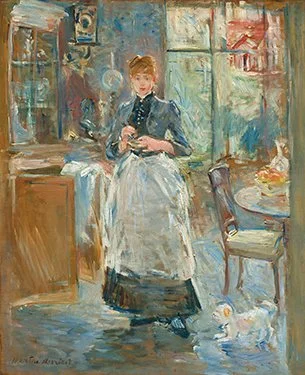Berthe Morisot, Little Girl Carrying a Basket, 1888, oil
Berthe Morisot
A founding member of the Impressionists, Berthe Morisot navigated the challenging waters of the nineteenth century male-dominated art world to become an important influence in modern art.
Berthe Morisot (1841-1895) was a French painter and key figure in the Impressionist movement. She garnered acclaim for her work during her lifetime yet is one of the most underappreciated artists of her time. Now, more than a century later, she is beginning to receive the respect she deserves.
Learning from tutors
Born into affluence in Bourges, France, Morisot was encouraged by her family to pursue art from a young age, however, as a female, she was barred from formal art training. Her parents hired tutors to teach her and she excelled. One of these, Joseph Guichard, gave a warning to Morisot’s parents about her talent which proved prophetic: “Given your daughter’s natural gifts, it will not be petty drawing room talents my instruction will impart; she will become a painter. Are you fully aware of what that means? It will be revolutionary, I would almost say catastrophic, in your high-bourgeois milieu.”
She continued her lessons from artists such as Jean-Baptiste-Camille Corot, an esteemed landscape painter, and registered at the Louvre as a copyist (one given permission to copy the artworks in the museum in order to improve their skills).
Berthe Morisot, Eugène Manet on the Isle of Wight, 1875, oil
Friendship with Édouard Manet
Morisot’s time at the Louvre brought her into contact with many other artists including Edgar Degas and Édouard Manet. She and Manet developed a close relationship based on mutual respect that strongly influenced each other’s work. Her paintings were affected by Manet’s interest in painting scenes of modern life, while Morisot inspired him to lighten his palette, create plein air paintings, and develop a looser application of paint on his canvas. Morisot was also a muse to Manet. She posed for him many times and they remained good friends until his death in 1883.
In 1874, Morisot married Manet’s younger brother, Eugène Manet, which also helped her make connections in the Paris art world and take advantage of artistic opportunities. The younger Manet was himself an artist and very supportive of his wife’s art career, often painting with her and serving as a model for several of her paintings.
Their daughter, Julie, posed for many of the Impressionists including her uncle Édouard and Renoir. She also married an artist, Ernest Rouart, and later wrote about her life in “Growing Up with the Impressionists: The Diary of Julie Manet.”
Berthe Morisot, In the Dining Room, c. 1875, oil
Exhibiting at the Salon de Paris
Morisot experienced a defining moment in her career in 1864 when, at age 23, she was selected to exhibit two landscape paintings at the prestigious Salon de Paris. Her work was selected for six subsequent Salon exhibitions until 1874 when she chose a different venue to showcase her art.
Developing an impressionistic technique
In 1871, Morisot’s style and technique had gone through a period of growth and creativity seen in loose brushstrokes; an influx of delicate light and color; and the focus on figural images. Painting rapidly, her work was characterized by its delicacy, spontaneity, and intuitive approach, often focusing on everyday domestic scenes and the lives of women, including many paintings of her daughter.
Trisha Adams, Summer Sunset, oil
Berthe Morisot, In the Wheatfield at Gennevilliers, 1875, oil
The first Impressionist exhibition
In 1873, Degas invited Morisot to join a group of artists forming the Anonymous Society of Painters, Sculptors, and Printmakers, an artists’ cooperative determined to free themselves from the restrictions of The Salon and exhibit their own work. Morisot became a founding member, the only woman in the group of 11 that included Claude Monet, Edgar Degas, Paul Cézanne, Alfred Sisley, Camille Pissarro, and Pierre-Auguste Renoir. These were the first Impressionists.
Their inaugural exhibition took place the following Spring; there were nine Morisot paintings included. Over the next 12 years, she participated in all but one of the seven subsequent exhibitions, missing only the year she gave birth to her daughter.
A lasting legacy
Morisot's dedication to the Impressionist cause earned her critical acclaim and recognition, securely establishing her position in the movement. Her work received praise for its distinctive style and technique.
In 1881, art critic Gustave Geffroy, said of her: “No one represents Impressionism with more refined talent or with more authority than Morisot.”
Morisot's fellow Impressionists respected her as a colleague and regarded her as a “virtuoso colorist.” Her impact on Impressionism and legacy as a trailblazer endures through her evocative paintings, which continue to captivate and inspire artists and art lovers the world over.





